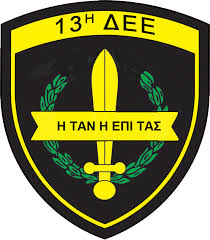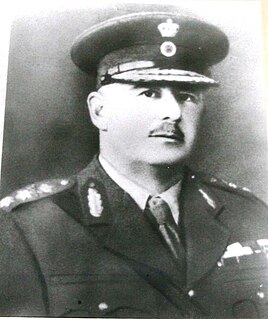
The I Army Corps was an army corps of the Hellenic Army, founded in December 1913. Originally based in Athens and covering southern Greece, since 1962 it was responsible for covering Greece's northwestern borders. It was disbanded in 2013.

The IV Army Corps is an army corps of the Hellenic Army. Established before the First World War, it served in all conflicts Greece participated in until the German invasion of Greece in 1941. Re-established in 1976, it has been guarding the Greco-Turkish land border along the Evros River, and is the most powerful formation in the Hellenic Army.
The following is the order of battle of the Hellenic Army during the First Balkan War.

Konstantinos Moschopoulos was a senior Greek Army officer who distinguished himself in the Balkan Wars of 1912–1913 and served as Chief of the Hellenic Army General Staff.
Panagiotis Spiliotopoulos was a Greek Army officer who rose to the rank of Lieutenant General and held the post of Chief of the Hellenic Army General Staff in 1946–1947, during the first stages of the Greek Civil War. He also served briefly as Minister of National Defence, Minister for Northern Greece and Secretary General of the Hellenic Red Cross.
The V Army Corps, sometimes found as Army Corps E, was an army corps of the Hellenic Army, active in the struggles in Northern Epirus in 1913–1914 and in the Greco-Italian War.
Ioannis Pitsikas was a Greek Army lieutenant general active in World War II, who served as Mayor of Athens and twice in cabinet posts in interim governments post-war.
The 20th Infantry Division was a short-lived formation of the Hellenic Army. It was founded on 24 January 1941, when Grece was already embroiled in the Greco-Italian War. Formed of reservists and with an incomplete table of equipment, it was assigned to the Central Macedonia Army Section (TSKM), forming part of the Greek–British "W Force", under the British Lt. General Henry Maitland Wilson. The division opposed the German invasion of Greece, but was defeated and practically ceased to exist as a combat formation at the Battle of Kleisoura Pass on 13–14 April.

Georgios Kosmas was a senior Greek Army officer who distinguished himself in the Greco-Italian War of 1940–1941, served as Chief of the Hellenic Army General Staff in 1949–51, and became a Member of the Hellenic Parliament and cabinet minister.
Dimitrios Giatzis was a senior Greek Army officer who held senior commands during the Greek Civil War of 1946–49, serving as commander of First Army and Chief of the Hellenic Army General Staff in 1947–49.

The 13th Special Operations Command "Sacred Band" is the umbrella unit of the Hellenic Army's special operation forces.
The Epirus Army Section was a field army of the Hellenic Army active between 14 February and 20 April 1941 during the Greco-Italian War and the Battle of Greece.
Dimitrios Papadopoulos was a Hellenic Army officer who reached the rank of Lieutenant General. He is most notable for his leadership in the Greco-Italian War of 1940–41.
Konstantinos Pallis was a Greek Army staff officer, who served as chief of staff of the Army of Asia Minor in 1920–22, and as Chief of the Hellenic Army General Staff during the Greco-Italian War of 1940–41.
The Central Macedonia Army Section was an army corps-level command of the Hellenic Army established on 6 March 1941. It was commanded by Lt. General Ioannis Kotoulas and comprised the 12th Infantry Division and the 20th Infantry Division. On 28 March it was assigned to Henry Maitland Wilson's 'W' Force, holding the Vermion Mountains–Haliacmon line. It was defeated and dissolved in mid-April 1941 during the German invasion of Greece.

The 4th Infantry Brigade was an infantry brigade of the Hellenic Army. Originally formed in 1897, it served until 1912. Re-formed in the lead-up to the Greco-Italian War in 1940, it was expanded and renamed as the 15th Infantry Division after the war started. It was again reactivated in 1998, and served until 2013.
The 7th Infantry Regiment is a historic infantry regiment of the Hellenic Army, and the predecessor of the 7th Mechanized Infantry Brigade.














